Facsimile
The successor in “almost-immediately obsolete contraptions” to the telex machine and, before that, the canal, nowadays the facsimile machine is mostly useful for affording bragging rights, both for those who can remember having to use them and what they were for[1], and those who can’t.[2]
|
The JC’s guide to electronic communication
|
The fax was desperate the last stand of the true analogue communication: a fax started out life as a nice piece of paper and ended up as a nasty one: a horrid, waxy, faded piece of parchment resembling the loo paper you used to get in nasty educational establishments.
Granted, there was a digital component to a fax transmission — the document was digitised and send across a PABX network as a series of ones and zeroes — only to be undigitised and rendered fully useless again at the other end, the usable digital information lost forever in a squeal and whirr of odd boinky noises and static. An analog version of the end-to-end principle: so close, but so far away.
A fax machine that dropped paper on the floor which curled up and rolled under a filing cabinet was an important McGuffin in the denouement of John Grisham’s espievie thriller, The Firm. Not to be out-done, Hunter Barkley’s forthcoming novel The ISDA Protocol is going to involve a malfunctioning telex.
